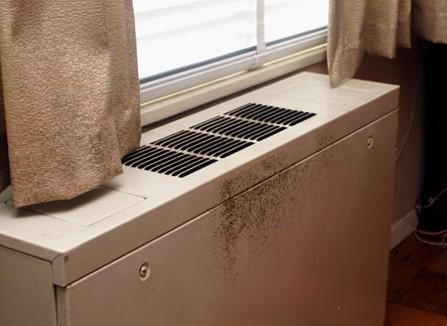Outdoor and Indoor Air Adaptation Strategies for Climate Change
The adaptation strategies provided below are intended to inform and assist communities in identifying potential alternatives. They are illustrative and are presented to help communities consider possible ways to address anticipated current and future climate threats to contaminated site management.
- Adaptation Strategies for Outdoor and Indoor Air
- Source Documents
- Disclaimer
Outdoor Air

Actions taken to reduce air pollutants will improve air quality even as the climate changes. Actions that reduce (mitigate) greenhouse gas emissions can also yield adaptation benefits.
A warming climate can worsen air quality which can aggravate lung diseases and lead to premature death.
Increases in ground level ozone (tropospheric ozone) pollution levels due to climate change may make it more difficult to attain or maintain ozone standards. This will need to be taken into account when designing effective ozone precursor emission control programs. For more on the causes of ground level ozone, and the difference between ground level ozone and the upper atmospheric ozone (stratospheric ozone) that protects us, see: EPA's Ozone Pollution webpage.
Climate change may also increase particulate matter (PM) levels through changes in the frequency or intensity of wildfires. The following strategies represent voluntary outdoor air strategies that states and localities can pursue to help adapt to anticipated climate changes. For information pertaining to regulatory requirements for NAAQS please visit the EPA's Clean Air Act page.
Actions that can improve air quality even as the climate changes include:
Voluntary Transportation Tips
- Reduce vehicle emissions by encouraging smart growth development.
- Choose a cleaner commute — car pool, use public transportation, bike or walk when possible.
- Combine errands to reduce "cold starts" of your car and avoid extended idling.
- Be sure your tires are properly inflated.
- Keep car, boat and other engines properly tuned, and avoid engines that smoke.
- Follow gasoline refueling instructions for efficient vapor recovery. Be careful not to spill fuel and always tighten your gas cap securely.
Household Tips
- Use environmentally safe paints and cleaning products whenever possible.
- Some products that you use at your home or office are made with smog-forming chemicals that can evaporate into the air when you use them. Follow manufacturers' recommendations for use and properly seal cleaners, paints, and other chemicals to prevent evaporation into the air.
- Conserve electricity. Consider setting your thermostat a little higher in the summer and lower in winter. Participate in local energy conservation programs. Look for the ENERGY STAR label when buying home or office equipment.
- Consider using gas logs instead of wood. If you use a wood-burning stove or fireplace insert, make sure it meets EPA design specifications. Burn only dry, seasoned wood.
Lawn and Garden Care Tips
Mulch or compost leaves and yard waste.
Days when ozone is expected to be high:
- Conserve electricity and set your air conditioner at a higher temperature.
- Choose a cleaner commute — car pool, or use public transportation.
- Refuel cars and trucks after dusk.
- Combine errands and reduce trips.
- Limit engine idling.
- Use household, workshop, and garden chemicals in ways that keep evaporation to a minimum, or try to delay using them during poor air quality days.
Days when particle pollution is expected to be high:
- Reduce or eliminate fireplace and wood stove use.
- Avoid using gas-powered lawn and garden equipment.
- Avoid burning leaves, trash and other materials.
Indoor Air

Climate change may worsen indoor air quality through exacerbating existing problems –including from mold or exposure to contaminants- and introduce new ones from altering the frequency or severity of adverse outdoor conditions.
Weatherization & Ventilation
It is essential to maintain proper ventilation to maintain healthy indoor environments. Proper ventilation is essential for moisture control and to dilute pollutants generated indoors.
Weatherization or retrofitting may include:
- installing storm windows
- weather stripping
- caulking
- insulating your home
It should also include an assessment of the ventilation required, and adjustment to the ventilation if needed, to accommodate weatherization changes in the home.
Preparing for Prolonged Power Outages
The increased frequency and duration of electrical power outages should be considered due to the increased frequency and severity of storms anticipated with climate change. Methods of ventilating buildings and maintaining acceptable thermal conditions using resilient or passive design strategies can be included in building design or modification strategies.
Source Documents
These strategies are adapted from existing EPA, CDC and other federal resources. Please view these strategies in the context provided by the primary source document:
- Protect Indoor Air Quality in Your Home
- Adapting Buildings for Indoor Air Quality in a Changing Climate
- U.S. Global Change Research Program – Climate and Health Assessment
- Reducing Urban Heat Islands: Compendium of Strategies
- Heat Island Cooling Strategies
Other Federal Resources:
Other potential adaptation strategies are available from industry organizations
- ASHRAE: American Society of Heating, Refrigerating, and Air-Conditioning Engineers Exit
- U.S. Green Building Standards Exit
- ISO: International Organization for Standardization Exit
Disclaimer
The adaptation strategies provided are intended to inform and assist communities in identifying potential alternatives. They are illustrative and are presented to help communities consider possible ways to address anticipated current and future climate threats to contaminated site management. Read the full disclaimer.
